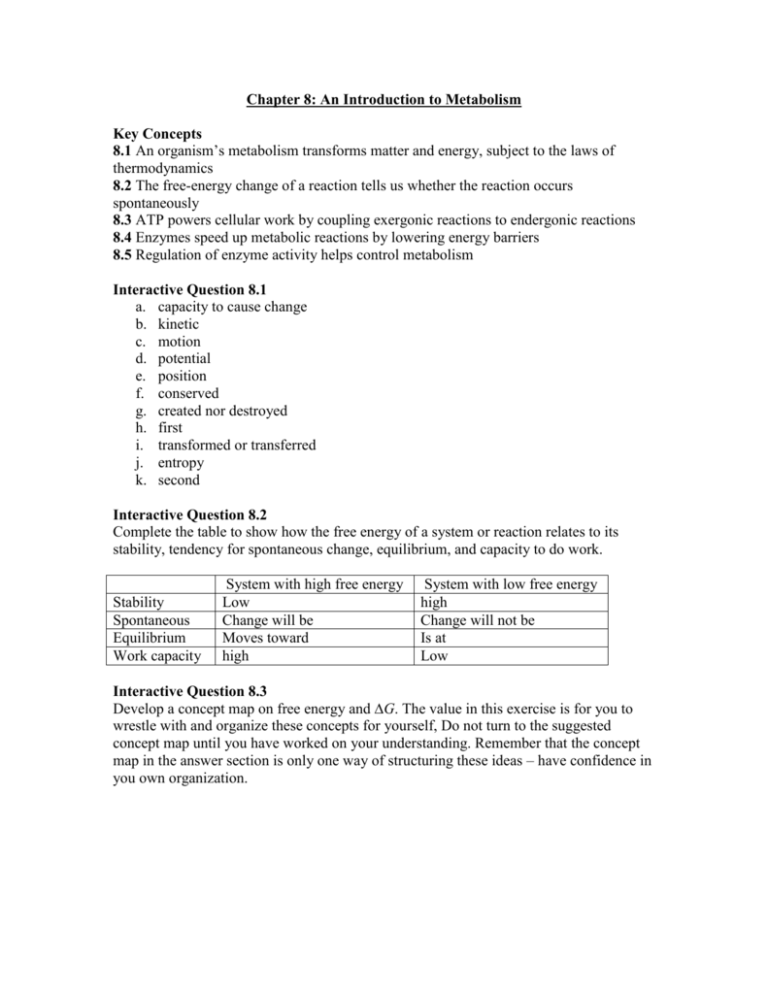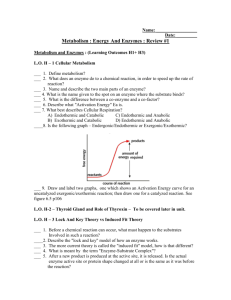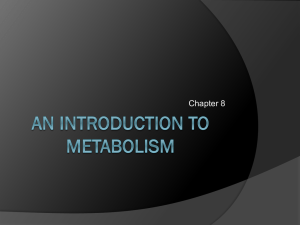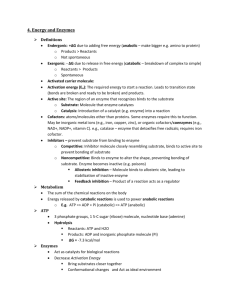Chapter 8: An Introduction to Metabolism
advertisement

Chapter 8: An Introduction to Metabolism Key Concepts 8.1 An organism’s metabolism transforms matter and energy, subject to the laws of thermodynamics 8.2 The free-energy change of a reaction tells us whether the reaction occurs spontaneously 8.3 ATP powers cellular work by coupling exergonic reactions to endergonic reactions 8.4 Enzymes speed up metabolic reactions by lowering energy barriers 8.5 Regulation of enzyme activity helps control metabolism Interactive Question 8.1 a. capacity to cause change b. kinetic c. motion d. potential e. position f. conserved g. created nor destroyed h. first i. transformed or transferred j. entropy k. second Interactive Question 8.2 Complete the table to show how the free energy of a system or reaction relates to its stability, tendency for spontaneous change, equilibrium, and capacity to do work. Stability Spontaneous Equilibrium Work capacity System with high free energy Low Change will be Moves toward high System with low free energy high Change will not be Is at Low Interactive Question 8.3 Develop a concept map on free energy and ∆G. The value in this exercise is for you to wrestle with and organize these concepts for yourself, Do not turn to the suggested concept map until you have worked on your understanding. Remember that the concept map in the answer section is only one way of structuring these ideas – have confidence in you own organization. Free energy Measure of determined by Energy available to do work ∆G = ∆H - T∆S ∆G is ∆H is T is ∆S is free energy change in total absolute change available energy of system temperature in to do work entropy when when measure of ∆G is negative ∆G is positive disorder or usually reaction is randomness decrease in H, reaction is endergonic increase in S spontaneous exergonic Interactive Question 8.4 Label the three components (a through c) of the ATP molecule shown below. a. adenine b. ribose c. 3 phosphate groups d. Indicate which bond is likely to break. By what chemical mechanism is the bond broken? A hydrolysis reaction breaks the terminal phosphate bond and releases a molecule of inorganic phosphate: ATP + H2O ADP + Pi e. Explain why this reaction releases so much energy? The negatively charged phosphate groups are crowded together, and their mutual repulsion makes this area instable. The chemical change to a more stable state of lower free energy accounts for the relatively high release of energy. Interactive Question 8.5 In this graph of an exergonic reaction with and without an enzyme catalyst, label the parts a through e. a. free energy b. transition state c. EA (free energy of activation) without enzyme d. EA with enzyme e. ∆G of the reaction Interactive Question 8.6 Outline a catalytic cycle using the diagrammatic enzyme below. Sketch two appropriate substrate molecules and two products, identify the enzyme-substrate complex, and describe the key steps of the cycle. (see pg. 153) Interactive Question 8.7 Return to your diagram in Interactive Question 8.6. Draw a competitive and a noncompetitive inhibitor, and indicate where each would bind to the enzyme molecule. A competitive inhibitor would mimic he shape of the substrates and compete with them for the active site. A noncompetitive inhibitor would be a shape that could bind to another site on the enzyme molecule and would change the conformation of the active site such that the substrates would no longer fit. Interactive Question 8.8 Both ATP and ADP serve as regulators of enzyme activity. In catabolic pathways, which of these molecules would you predict would act as an inhibitor? Which molecule would you expect to act as an activator of anabolic pathways? ATP would act as an inhibitor to catabolic pathways, slowing the breakdown of fuel molecules if sufficient energy is available in the cell. ATP may act as an activator of anabolic pathways that store resources in more complex molecules. Structure You Knowledge This chapter introduced many new and complex concepts. See if you can step back from the details and answer the following general questions. 1. Relate the concept of free energy to metabolism. Metabolism is the totality of chemical reactions that take place in living organisms. To create and maintain the structural order required for life requires an input of free energy – from sunlight for photosynthetic organisms and from energy-rich food molecules for other organisms. A cell couples catabolic exergonic reactions (-∆G) with anabolic, endergonic reactions (+∆G), using ATP as the primary energy shuttle between the two. 2. What role do enzyme play in metabolism Enzymes are essential for metabolism because they lower the activation energy of the specific reactions they catalyze and allow those reactions to occur extremely rapidly at a temperature conducive to life. By regulating the enzymes it produces, a cell can regulate which of the myriad of possibly chemical reactions take place at any given time. Metabolic control also occurs through allosteric regulation and feedback inhibition. The compartmental organization of a cell facilitates a cell’s metabolism. Test You Knowledge Multiple Choice: Choose the one best answer. 1. Catabolic and anabolic pathways are often coupled in a cell because c. the free energy released from one pathway is used to drive the other (142) 2. When glucose and oxygen are converted to CO2 and H2O, changed in total energy, entropy, and free energy are as follows. b. -∆H, +∆S, -∆G (145) 3. When a protein forms from amino acids, the following energy and entropy changes apply: a. +∆H, -∆S, +∆G (145) 4. A negative ∆G means that e. all of the above are true (145) 5. According to the first law of thermodynamics c. the total amount of energy in the universe s conserved or constant (143) 6. What is meant by an induced fit? c. the binding of the substrate changes the shape of the active site, which can stress or bend substrate bonds (152) 7. One way in which a cell maintains metabolic disequilibrium is to a. siphon products of a reaction off the next step in a metabolic pathway (147) 8. In an experiment, changing the pH from 7to 6 resulted in an increase in product formation. From this we could conclude that e. the enzyme was in a more active conformation at pH 6 (147) 9. When substance A was added to an enzyme reaction, product formation decreased. The addition of more substrate did not increase product formation. From this we conclude that substance A could be e. a noncompetitive inhibitor (155) 10. The formation of ATP from ADP and inorganic phosphate c. produces an unstable energy compound that can drive cellular work (148) 11. At equilibrium, b. free energy is at a minimum (147) 12. In cooperativity, c. a molecule bound to the active site f one subunit of an enzyme affects the active site of other subunits (157) 13. When a cell breaks down glucose, only about 40% of the energy is captured in ATP molecules. The remaining 60% of the energy is b. lost as heat because of the second law of thermodynamics (149) 14. An endergonic reaction could be described as one that will b. produce products with more free energy than the reactants (146) 15. What is most directly responsible for the specificity of a protein enzyme? e. the R groups of the amino acids in its active site (158) 16. Which of the following parameters does an enzyme raise? d. speed of reaction (150) 17. Zinc, an essential trace element, may be found bound to the active site of some enzymes. What would be the most likely function of such zinc ions? b. a cofactor necessary for catalysis (155) 18. Which line in the diagram above indicates the ∆G of the enzyme-catalyzed reaction of L M + N? D (152) 19. Which line in the diagram indicates the activation energy of the noncatalyzed reaction? C (152) 20. Which of the following terms would best describe this reaction? b. -∆G (152) 21. A reaction that is spontaneous e. is exergonic (146) 22. In the metabolic pathway, ABCDE, what effect would molecule E likely have on the enzyme that catalyzes AB? a. allosteric inhibitor (156) Fill in the Blanks 1. the totality of an organism’s chemical processes (metabolism) 2. pathways that require energy to combine molecules together (anabolic) 3. the energy of motion (kinetic) 4. enzymes that change between two conformations, depending on whether an activator or inhibitor is bound to them (allosteric) 5. term for the measure of disorder or randomness (entropy) 6. the energy that must be absorbed by molecules to reach the transition state (free energy of activation) 7. inhibitors that decrease an enzyme’s activity by binding to the active site (competitive inhibition) 8. organic molecules that bind to enzymes and are necessary for their functioning (coenymes) 9. regulatory device in which he product of a pathway binds to an enzyme early in the pathway (feedback inhibition) 10. more reactive molecules created by the transfer of a phosphate group from ATP (phosphorylated intermediate)









